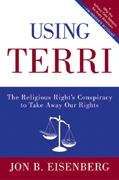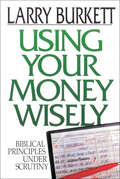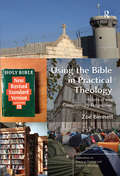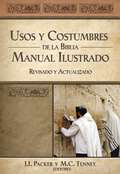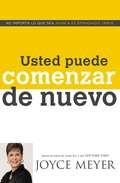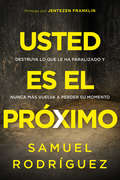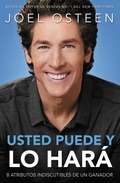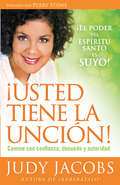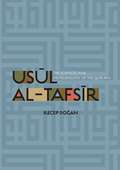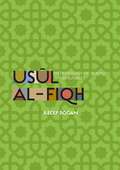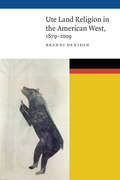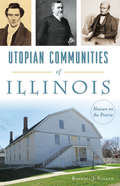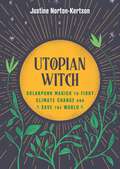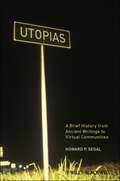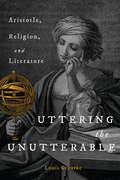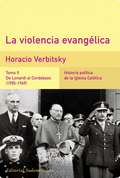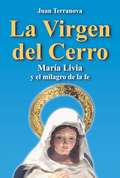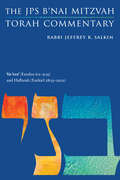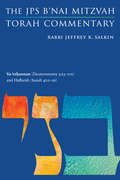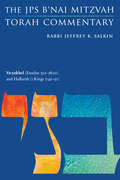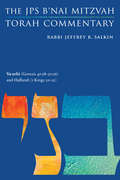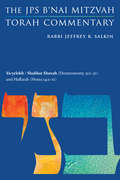- Table View
- List View
Using Spirituality in Psychotherapy: The Heart Led Approach to Clinical Practice
by Alexandra DentUsing Spirituality in Psychotherapy: The Heart Led Approach to Clinical Practice offers a means for therapists to integrate a spiritual perspective into their clinical practice.The book provides a valuable alternative to traditional forms of psychotherapy by placing an emphasis on purpose and meaning. Introducing a spiritually informed model, Heart Led Psychotherapy (HLP), the book uses a BioPsychoSocioSpiritual approach to treat psychological distress. Based on the premise that everyone is on an individual life journey, HLP teaches clients to become an observer, identifying the life lessons that they are being asked to understand or experience. The model can be used whether a client has spiritual beliefs or not, enabling them to make new choices that are in keeping with their authentic selves and to live a more fulfilled and peaceful life. This new edition includes updated references and new material on transpersonal psychology, spiritual awakening, working within the quantum field, significance of the heart and heart coherence.Illustrated by case studies to highlight key points and including a range of practical resource exercises and strategies, this engaging book will have wide appeal to therapists and clinicians from a variety of backgrounds.
Using Terri: The Religious Right's Conspiracy to Take Away Our Rights
by Jon B. EisenbergThe Terri Schiavo case centerred around the removal of a feeding tube from a dying woman. Eisenberg, who served as one of the lead attorneys on Michael Schiavo's side, asserts that the Terri Schiavo case was a key battle in a larger political struggle over abortion, stem-cell research, physician-assisted suicide, gay rights, and the appointment of federal judges. The religious Right chose to make it a national spectacle because they thought they could win. They were wrong. But there are many more battles to come. Jon Eisenberg, who served as one of the lead attorneys on Michael Schiavo's side, exposes the religious Right's strategies and follows the money trail to reveal how they are organized, who is funding the movement, and where we can expect future legal maneuvers to combat the American traditions of autonomy and freedom. Jon Eisenberg has experienced the family struggle of removing a feeding tube from a loved one and witnessed firsthand the Florida drama that will continue to have national legal and political consequences for years to come. What tactics can we expect to see in courtrooms and state legislatures all across this country in the days ahead? Who is behind the funding and what do they hope to accomplish and when? What are the religious and bioethical issues that are at the center of these debates and how will they affect future legal battles? Using Terri gives us a behind-the-scenes look at what happened -- and what's coming. Author Info. Jon B. Eisenberg teaches appellate procedure at the University of California's Hastings College of the Law in San Francisco.
Using Your Money Wisely: Biblical Principles Under Scrutiny
by Larry BurkettNearly 80 percent of all divorced couples between the ages of 20 and 30 list financial difficulties as the primary cause of their separation. Even some of the most dedicated Christians are facing the perils of bankruptcy and overextended credit. We are seeing just some of the effects of living in a materialistic society.Larry Burkett, renowned for his Christian Financial Concepts ministry, dedicated himself to helping people understand what the Scripture says about finances. Through a series of outstanding articles taken from CFC newsletters, Using Your Money Wisely clearly demonstrates God&’s principles for prudent money management
Using Your Money Wisely: Biblical Principles Under Scrutiny
by Larry BurkettNearly 80 percent of all divorced couples between the ages of 20 and 30 list financial difficulties as the primary cause of their separation. Even some of the most dedicated Christians are facing the perils of bankruptcy and overextended credit. We are seeing just some of the effects of living in a materialistic society.Larry Burkett, renowned for his Christian Financial Concepts ministry, dedicated himself to helping people understand what the Scripture says about finances. Through a series of outstanding articles taken from CFC newsletters, Using Your Money Wisely clearly demonstrates God&’s principles for prudent money management
Using the Bible in Practical Theology: Historical and Contemporary Perspectives (Explorations in Practical, Pastoral and Empirical Theology)
by Zoë BennettExploring how the Bible may be appropriately used in practical and public theology, this book looks at types of modern practical theology with specific emphasis on the use of the Bible. Bennett juxtaposes the diversity of modern practical theology with the work of leading nineteenth-century public 'theologian', John Ruskin, and then assesses the contribution of this analysis to some modern issues of public importance in which the Bible is used. The final chapter offers a framework for a biblically informed critical practical theology which draws on the writer's experience and invites the readers to engage their own.
Usos y costumbres de la Biblia: Manual ilustrado, revisado y actualizado
by J. I. PackerDeje que las Escrituras cobren vida en este estudio de unvolumen de la vida y los tiempos de la Biblia que todos deben tener.Esta guíaenciclopédica totalmente ilustrada de los usos, costumbres y épocas de laBiblia pone una cantidad impresionante de información al alcance de sus dedos. Másde cuarenta secciones abarcan gente de la Biblia y cómo vivía, desde la vida enfamilia hasta la ley y el transporte. Este volumen de precio cómodo ofrece másde 6,000 temas y datos, haciendo que las maravillas de las culturas bíblicassean más accesibles que nunca.
Usted Puede Comenzar de Nuevo: No Importa lo que Sea, Nunca es Demasiado Tarde
by Joyce MeyerNunca es demasiado tarde para un nuevo comienzo. Observe detenidamente y verá ese tema expuesto a lo largo de toda la Biblia. Página tras página, Dios se deleita en convertir finales trágicos en nuevos comienzos. Una mujer estéril concibe en su vejez, un temeroso y tímido pastor de ovejas se convierte en un líder de millones, y una prostituta se convierte en esposa y madre en el linaje de Cristo. Cada nuevo comienzo en la Biblia revela la maravillosa e inspiradora esperanza que tenemos en nuestros propios nuevos comienzos en el plan de Dios para nuestras vidas. En USTED PUEDE COMENZAR DE NUEVO, la autora de éxitos de librería Joyce Meyer explora la belleza y el carácter inagotable del amor y la gracia de Dios. A través de historias inspiradoras, principios bíblicos y su típico enfoque práctico, Joyce demuestra fuertemente que Dios no ha terminado aún con usted. Si usted está atascado en un bache, decepcionado por los resultados, dolido por una herida, fracasando en el intento, luchando en una relación, o no está seguro sobre el futuro. . . no se rinda. No renuncie a usted mismo ni renuncie del Dios que le ama y le ofrece un nuevo comienzo hoy. "Dios siempre ofrece una nueva oportunidad. Una nueva posibilidad. Una nueva vida. Esa vida puede ser suya hoy. ¡Usted puede comenzar de nuevo!"
Usted es el próximo / You're Next: Destruya lo que le ha paralizado y nunca más vuelva a perder su momento
by Samuel RodriguezNO VUELVA A PERDER SU TURNO Por medio del pasaje en el que Jesucristo sana al paralítico de Betesda el Rev. Samuel Rodríguez ilustra de manera poderosa cómo su "tendencia hacia la dependencia" podría estar estorbando su milagro. Usted es el próximo le muestra cómo: Dejar ir las etiquetas que usted permitió que lo definieran.Avanzar más allá de las barreras que lo limitan.Descartar las cualificaciones que usted le ha añadido a la orden de Jesucristo de levantarse y andar.Dejar de verse cono víctima de sus circunstancias.Ver sus circunstancias como sujetas a la autoridad y el poder de Jesucristo. Su futuro no está controlado por los "y si...". Descansa en las manos de Aquél que lo ama, lo sana, y lo redime. Deje ir sus excusas, avance más allá de la vida condicional y rompa su ciclo de dependencia.Most people never seize their moment because they are paralyzed by their own thinking.This book will teach you to let go of your excuses and never miss your moment again. It&’s time for a change! It&’s time to hear the voice of Jesus asking, &“Do you want to get well?&” And it&’s time to answer Him with your obedience. Your destiny, future, and family are not controlled by &“if only&”; they rest in the hands of the One who loves you, saves you, redeems you, and heals you. Let go of your excuses, move beyond your conditional living, and break your cycle of dependency. It&’s time to stand! Have you convinced yourself the abundant life Jesus came to bring is out of reach? Have you developed an &“if only&” mentality, waiting for something or someone to turn things around? While you become more and more dependent on your excuses, you watch others get what you want to have, go where you want to go, and experience what you long to feel. It seems it&’s never your turn to experience the joy that comes from attaining all God has for you. In You Are Next, Rev. Samuel Rodriguez uses the story of Jesus healing the paralytic to powerfully illustrate that your &“tendency for dependency&” could be standing in the way of your miracle. He challenges you to do what&’s necessary to receive it and shows you how to: Let go of old labels you&’ve allowed to define youMove beyond barriers that limit youStop seeing yourself as a victim and start seeing your circumstances as subject to the authority and power of Jesus ChristLet go of the qualifications you think are tacked on to Jesus&’ command to get up and walk It&’s time to step out in faith! You are next!
Usted puede, y lo hará: 8 atributos indiscutibles de un ganador
by Joel OsteenIn YOU CAN, YOU WILL, Joel Osteen shares eight undeniable qualities of winners that can help you to reach your potential and achieve new levels of success in your life. You are created to be a winner. Get these eight principles deep down on the inside and boldly go in the direction of your destiny. Keep Your Vision in Front of You - Dare to dream big dreams. Run Your Race - Focus on your unique course and goals. Expect Good Things - Anticipate great opportunities. Have a Positive Mind-set - Take control of your thoughts and attitudes. Commit to Excellence - Do your best and maintain high standards. Keep Growing - Be proactive, be intentional, build on your gifts, and continually improve. Serve Others - Invest yourself in others. Stay Passionate - Light the fire within and approach life with enthusiasm. is the control center for your life.
Usted tiene la unción: Camine con confianza, denuedo y autoridad
by Judy JacobsDios desea hacer cosas extraordinarias a través de ti Dios ha bendecido a cada uno de sus hijos con sus dones, y Él quiere que los utilice para hacer avanzar su Reino y ver vidas cambiadas. No importa el don que tenga, y adónde Dios lo haya llamadao, ¡necesita saber que usted tiene la unción! · Posiblemente esté pasando por una dura temporada en este momento. ¡Necesita saber que USTED TIENE LA UNCION! · Probablemente haya recibido un mal informe de su médico. ¡Necesita saber que USTED TIENE LA UNCION! . Quizás se encuentre en la lucha de su vida por su matrimonio, sus hijos, su hogar... crea solamente esto: USTED TIENE LA UNCION! . Quizás haya sido llamado para servir a otros, aquellos menos afortunados, o de otros país. ¡Necesita saber que USTED TIENE LA UNCION! Prepárese a conocer una unción que usted nunca se imaginó que fuera posible, simplemente porque usted es capaz de reconocer y declarar: "Oye, ¿sabes qué El Espíritu del Señor Dios ESTA sobre MI, ¡y yo tento la unción para esto!".
Usul al Tafsir: The Sciences and Methodology of the Qur'an
by Recep DoganThis valuable work on the methodology of exegesis by Dr. Recep Dogan will serve as an important source of future works in the field. With his expertise in the history and exegesis of the Qur'an, as well as his familiarity and comprehensive understanding of Islamic disciplines, Dr. Dogan has managed to combine both classical and modern acquis. Presenting a variety of different approaches, Dr. Dogan also offers a broad range of Western approaches in reading the Qur'an.
Usul al-Fiqh: Methodology of Islamic Jurisprudence
by Recep DoganThis book deals with the sources of Islamic jurisprudence and their importance in deducing the religious rulings. It covers the concept of ijtihād (independent reasoning), its conditions and application and illustrates why it is a practice for experts rather than laymen. It also explains the differences in the levels of expertise of the mujtahids. In fact, there are seven distinct classifications of mujtahid.The book also covers the communication of God as Lawgiver with regard to the conduct of liable persons. It details the difference in probative value of communication based on the extent to which it binds an individual be it absolutely binding, a recommendation or mere permissibility.The reader will be able to understand the difference between fiqh (law) and Usūl al-Fiqh (methodology of law). Fiqh is the law itself whereas Usūl al-Fiqh is the methodology utilized to extract the law. The relationship between the two disciplines resembles that of the rules of grammar to a language, or of logic to philosophy. Usūl al-Fiqh in this sense provides the standard criteria for the correct deduction of the rulings of fiqh from the sources of Shari&’ah (the Qur&’an and Sunnah).
Ute Land Religion in the American West, 1879–2009 (New Visions in Native American and Indigenous Studies)
by Brandi DenisonUte Land Religion in the American West, 1879–2009 is a narrative of American religion and how it intersected with land in the American West. Prior to 1881, Utes lived on the largest reservation in North America—twelve million acres of western Colorado. Brandi Denison takes a broad look at the Ute land dispossession and resistance to disenfranchisement by tracing the shifting cultural meaning of dirt, a physical thing, into land, an abstract idea. This shift was made possible through the development and deployment of an idealized American religion based on Enlightenment ideals of individualism, Victorian sensibilities about the female body, and an emerging respect for diversity and commitment to religious pluralism that was wholly dependent on a separation of economics from religion. As the narrative unfolds, Denison shows how Utes and their Anglo-American allies worked together to systematize a religion out of existing ceremonial practices, anthropological observations, and Euro-American ideals of nature. A variety of societies then used religious beliefs and practices to give meaning to the land, which in turn shaped inhabitants’ perception of an exclusive American religion. Ultimately, this movement from the tangible to the abstract demonstrates the development of a normative American religion, one that excludes minorities even as they are the source of the idealized expression.
Utopian Communities in America 1680-1880 (Dover Books on History, Political and Social Science)
by Mark HollowayOriginally entitled Heavens on Earth, this book provides an overview of utopian communities in the thirteen colonies and in the United States. It begins with Utopian movements in Europe and explores how the New World provided rich ground where idealistic communities could put down roots. The most successful utopian communities had strong religious precepts and often were controlled by charismatic leaders. United by a common belief system and purpose, members of the community shared their material possessions and worked for what they believed to be a common good. With tongue in cheek humor that reveals the failings of leaders and ideology, the author examines such communities as Ephrata, New Harmony, Brook Farm, the Shaker societies, and many more.
Utopian Communities of Illinois: Heaven on the Prairie
by Randall J. SolandThe Prairie State became a crucial testing ground for the grand American thought experiment on how a society should be constructed. Between 1839 and 1901, six different utopian communities chose Illinois as the laboratory and sanctuary to elevate their ideals into reality. The Mormons and the Icarians selected Nauvoo. The Janssonists picked Bishop Hill. The Fourierists settled on the north edge of Loami. The employees of the Pullman Railroad Car Company naturally resided in Pullman, and the Dowietes put down roots in Zion. Three were religious and the others secular. All possessed charismatic leaders and dramatic stories that drew attention from across the globe. Randy Soland examines the relationship between these havens and their legacies.
Utopian Witch: Solarpunk Magick to Fight Climate Change and Save the World
by Justine Norton-KertsonThis solarpunk book of shadows will guide you in surviving and resisting climate crisis and dystopian political systems so you can take radical action towards a positive future. Longtime activist and practicing witch Justine Norton-Kertson introduces a fresh approach to witchcraft at a time when it&’s desperately needed. Drawing on the natural connections between modern paganism and the literary, artistic, and activist movement known as solarpunk, Norton-Kertson provides meditations and correspondences for developing a spiritual practice rooted in nature, the Sun, and a powerful belief in our ability to build a better world. Readers will also find a host of spells to use in the fight against climate change, fascism, and inequality. These politically conscious magickal practices forge a new spiritual praxis to guide us as we work together to envision and create the future we want to see.
Utopias: A Brief History from Ancient Writings to Virtual Communities (Wiley Blackwell Brief Histories of Religion #48)
by Howard P. SegalThis brief history connects the past and present of utopian thought, from the first utopias in ancient Greece, right up to present day visions of cyberspace communities and paradise. Explores the purpose of utopias, what they reveal about the societies who conceive them, and how utopias have changed over the centuries Unique in including both non-Western and Western visions of utopia Explores the many forms utopias have taken – prophecies and oratory, writings, political movements, world's fairs, physical communities – and also discusses high-tech and cyberspace visions for the first time The first book to analyze the implicitly utopian dimensions of reform crusades like Technocracy of the 1930s and Modernization Theory of the 1950s, and the laptop classroom initiatives of recent years
Uttering the Unutterable: Aristotle, Religion, and Literature
by Louis F. GroarkeLiterature utters the unutterable, not through logic, not through science, not through argument, but through a pitch of eloquence so pronounced the conscientious reader cannot fail to pay attention.Louis Groarke argues that literature is an honorific term we use to describe texts that are so overpowering they lift us to an encounter with an ineffable ultimate that is beyond logical or scientific explanation. In Uttering the Unutterable he proposes a wisdom epistemology that identifies an experience of transcendence as the defining criterion of literature. Offering four mutually reinforcing definitions of literature in line with Aristotle’s theory of four causes, Groarke compares the experience of reading to Aristotle’s account of philosophical contemplation and maintains that literature has inevitable ethical content. Moving beyond the Aristotelianism of the late Chicago School, Groarke presents a new synthesis that breaks through essentialist stereotypes and contends that literature, like religion, points to an ineffable transcendental, to something beyond what we can adequately explain, prove, systematize, quantify, or enclose in a theory.Uttering the Unutterable explores how Aristotelian philosophy provides the most complete and compelling account of literature for philosophers, literary critics, and theorists.
VIOLENCIA EVANGELICA, LA (EBOOK)
by Horacio VerbitskyEste es el segundo tomo de la Historia Política de la Iglesia Católica, que comenzó con Cristo vence. Lonardi trajo la ilusión de una nueva Cristiandad que fusionara política y religión. Pero el abismo con el pueblo que produjo el golpe contra Perón amenazó la razón de ser de la Iglesia. Muchos sacerdotes se acercaron a los trabajadores y algunos obispos a la dirigencia sindical. Pese a la renovación conciliar, el cardenal Caggiano santificó la dictadura de Onganía. El vicariato castrense, Meinville, Genta, Sacheri y la Cité Catholique francesa adosctrinaron a las FFAA para la cruzada represiva contra la soberanía del pueblo. Los sacerdotes del tercer mundo fueron de la pastoral popular a la acción política. La jerarquía juró participar en el proceso de liberación con #la violencia evangélica del amor#. Pero asustada por el cordobaza se encerró con las FFAA en la fortaleza del nacional- catolicismo, asediada por la modernidad de la revolución.
VIRGEN DEL CERRO, LA (EBOOK)
by Juan TerranovaA mediados de 1990, María Livia Galliano de Obeid, un ama de casa salteña con tres hijos, comienza a escuchar una voz. Es la Virgen María que le habla y le pide que le erija un santuario en un cerro. Actualmente miles de peregrinos de la Argentina y el mundo viajan cada sábado a Tres Cerritos, Salta, para recibir la Oración de Intercesión en la que María Livia, con sólo apoyarles su mano en el hombro, los hace caer de espaldas. La Virgen del Cerro es el primer libro que retrata seriamente este fenómeno. Pero es también la crónica de las peregrinaciones hasta el cerro de las apariciones y la fascinante historia de vida de María Livia y de incontables testimonios de fe, milagros y bendiciones recibidas. Juan Terranova narra la aparición de la Virgen en Salta y examina los detalles de un acontecimiento tan masivo como secreto. La Virgen del Cerro presenta así un recorrido por el camino de la mayor manifestación de fe vivida en la Argentina durante los últimos años.
Va-'era': The JPS B'nai Mitzvah Torah Commentary (JPS Study Bible)
by Rabbi Jeffrey K. SalkinVa-'era' (Exodus 6:2-9:35) and Haftarah (Ezekiel 28:25-29:21): The JPS B’nai Mitzvah Torah Commentary shows teens in their own language how Torah addresses the issues in their world. The conversational tone is inviting and dignified, concise and substantial, direct and informative. Each pamphlet includes a general introduction, two model divrei Torah on the weekly Torah portion, and one model davar Torah on the weekly Haftarah portion. Jewish learning—for young people and adults—will never be the same. The complete set of weekly portions is available in Rabbi Jeffrey K. Salkin’s book The JPS B’nai Mitzvah Torah Commentary (JPS, 2017).
Va-'ethannan: The JPS B'nai Mitzvah Torah Commentary (JPS Study Bible)
by Rabbi Jeffrey K. SalkinThe JPS B’nai Mitzvah Torah Commentary shows teens in their own language how Torah addresses the issues in their world. The conversational tone is inviting and dignified, concise and substantial, direct and informative. Each pamphlet includes a general introduction, two model divrei Torah on the weekly Torah portion, and one model davar Torah on the weekly Haftarah portion. Jewish learning—for young people and adults—will never be the same. The complete set of weekly portions is available in Rabbi Jeffrey K. Salkin’s book The JPS B’nai Mitzvah Torah Commentary (JPS, 2017).
Va-yakhel: The JPS B'nai Mitzvah Torah Commentary (JPS Study Bible)
by Rabbi Jeffrey K. SalkinVa-yakhel (Exodus 35:1-38:20) and Haftarah (1 Kings 7:40-50): The JPS B’nai Mitzvah Torah Commentary shows teens in their own language how Torah addresses the issues in their world. The conversational tone is inviting and dignified, concise and substantial, direct and informative. Each pamphlet includes a general introduction, two model divrei Torah on the weekly Torah portion, and one model davar Torah on the weekly Haftarah portion. Jewish learning—for young people and adults—will never be the same. The complete set of weekly portions is available in Rabbi Jeffrey K. Salkin’s book The JPS B’nai Mitzvah Torah Commentary (JPS, 2017).
Va-yehi: The JPS B'nai Mitzvah Torah Commentary (JPS Study Bible)
by Rabbi Jeffrey K. SalkinVa-yehi (Genesis 47:28-50:26) and Haftarah (1 Kings 2:1-12): The JPS B’nai Mitzvah Torah Commentary shows teens in their own language how Torah addresses the issues in their world. The conversational tone is inviting and dignified, concise and substantial, direct and informative. Each pamphlet includes a general introduction, two model divrei Torah on the weekly Torah portion, and one model davar Torah on the weekly Haftarah portion. Jewish learning—for young people and adults—will never be the same. The complete set of weekly portions is available in Rabbi Jeffrey K. Salkin’s book The JPS B’nai Mitzvah Torah Commentary (JPS, 2017).
Va-yelekh / Shabbat Shuvah: The JPS B'nai Mitzvah Torah Commentary (JPS Study Bible)
by Rabbi Jeffrey K. SalkinThe JPS B’nai Mitzvah Torah Commentary shows teens in their own language how Torah addresses the issues in their world. The conversational tone is inviting and dignified, concise and substantial, direct and informative. Each pamphlet includes a general introduction, two model divrei Torah on the weekly Torah portion, and one model davar Torah on the weekly Haftarah portion. Jewish learning—for young people and adults—will never be the same. The complete set of weekly portions is available in Rabbi Jeffrey K. Salkin’s book The JPS B’nai Mitzvah Torah Commentary (JPS, 2017).

